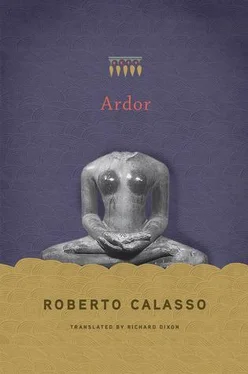But there was something that interrupted them: death. Man is conceived, then “lives so long as he lives. When he dies, he is placed on the fire. His fire is Agni, the logs the logs, the smoke the smoke, the flame the flame, the embers the embers, the sparks the sparks.” Until a moment earlier, it seemed that the embers and the sparks might be transformed into anything whatsoever — and that everything was ready to be transformed into them. But now, all of a sudden, they were just embers and sparks, simple repetitions of themselves. Now, at the moment of cremation, it turned out that the logs were the logs, the flame was the flame — and, even if out of discretion it wasn’t spelled out, the corpse was the corpse. It is difficult to imagine an inference of death that could be harsher, more unclouded, more clear-cut than these few tautological words.
* * *
“Thereupon he goes off, on foot or by cart; and, when he has reached what he considers to be the boundary, he breaks silence. And when he returns from his journey he maintains silence from the moment when he sees what he considers to be the boundary. And, even if there were a king in his house, he would not go to him [before having paid homage to the fires].” Behind the terse prose of the ritualist, we glimpse all the pathos of the journey: of any journey, as though Nerval or Proust were to recognize their own bedrock here. One has truly departed, and therefore can leave the silence that distinguishes the delicate phase of transition, only when the fires — or, according to another commentator, the roof of one of the fire huts — can no longer be seen. And the same when returning. Homeland, home — these are the fires. Even if a king were in your house, you have to pay homage first of all to the fires. There is something so intimate, so direct, so secret in each person’s relationship with his fires that it seems to suggest a model for every personal relationship.

The altar is a woman with perfect proportions: “With broad hips, shoulders a little less broad, and narrow at the waist.” Like a woman, it must not be naked. It is sprinkled with fine gravel or sand, so as to cover its body with a light gleaming film (“gravel is certainly an adornment, since gravel is fairly luminous”). Then with twigs and grass. The woman — the altar — makes herself beautiful, is helped to look beautiful, ready for the arrival of the gods. And so she passes a night.
At last she meets her lover, fire, “for the altar ( vedi ) is female and the fire ( agni ) is male. And the woman lies there embracing the man. And so a fruitful intercourse takes place. This is why he raises the two extremes of the altar on two sides of the fire.” Every sacrificial act is interwoven with a sexual act. And vice versa. This is the nature of how things are. Arranged to attract the gods, so that the gods are aware of the sacrifice. How is it done? How can the altar be made “pleasing to the gods”? By ensuring as far as possible that it resembles a beautiful woman. The altar, then, cannot be just a roughly hewn stone. Instead “it should be broader on the west side, narrower in the middle, and broad again on the east side.” Thus, looking at it, the gods cannot fail to feel attracted, as if by a beautiful woman lying motionless in a clearing. Awaiting her lover, her officiant, her victim.
* * *
The sacrificial setting was also an erotic one. One in which the intercourse didn’t have to take place under the eyes of many, as in the horse sacrifice. Sometimes the appearance of a female was enough for the seed to be spilled. This was how some of the most powerful ṛṣis were born, owing to the superabundance of their mental life. They were born, in fact, without their father needing to touch the body of their mother. So pervasive was his desire, kāma , that Prajāpati — Kāma was another of his names — spilled his seed at the mere sight of Vāc during a long sacrifice. It was a three-year sattra that he was celebrating together with the Devas and even with the Sādhyas, the mysterious gods who had preceded the Devas: “There, at the initiation ceremony, Vāc arrived in bodily form. Upon seeing her, the seed of Ka and of Varuṇa spilled simultaneously. Vāyu, Wind, scattered it into the fire as he pleased. Then from the flames was born Bhṛgu, and the seer Aṅgiras from the embers. Vāc, upon seeing her two sons, while she herself was seen, said to Prajāpati: ‘May a third seer, in addition to these two, be born as my son.’ Prajāpati, to whom these words were spoken, said ‘let it be so’ to Vāc. Then the seer Atri was born, equal in splendor to Sun and Fire.”
This occasion was not unusual among the many events we come across in the life of Prajāpati. On the contrary, it was a pattern that was set to recur, over and over again. Such episodes appeared frequently in the stories of the Devas and the ṛṣis. If it is not Prajāpati spilling his seed, it is his four sons — Agni, Vāyu, Āditya, Candramas — who spill it watching Uṣas passing before them. Mitra and Varuṇa spill it into a ritual bowl, during the soma rite, while they watch Urvaśī. And there are many stories of ṛṣis who spill their seed watching an Apsara (Bharadvāja watching Ghṛtācī, Gautama watching Śāradvatī, Nārada watching a group of Apsaras bathing). These scenes show one of the ṛṣis in solitary meditation, who is disturbed by the sudden appearance of a female being, generally an Apsara. But, for the gods, everything happens during a sacrifice, as if the erotic charge were always there and ready to be released at every liturgical scene. And the theory envisaged it. On various occasions, to justify the silence that has to accompany particular parts of the ritual, the Śatapatha Brāhmaṇa says: “For here in the sacrifice there is seed, and the seed is spilled in silence.” From the moment when the fires are kindled to the end of the liturgy we find ourselves inside a field of erotic tension — and actions culminate in moments of silence in which the seed is spilled.
The ṛṣis born from the sacrificial blaze have a mother, because the flames are the vagina of she who has seduced that god or those gods who have procreated them. And so Vāc will demand another son from Prajāpati from the same flames that have produced Bhṛgu and Aṅgiras. Considering how persistently the theory and practice of semen retention has been developed in India, culminating in Tantrism, it is all the more astonishing how often scenes of semen emission without contact appear in the earliest texts. The Ṛgveda describes it with total clarity in relation to Mitra and Varuṇa before the appearance of Urvaśī: “During a soma sacrifice, excited by the oblations, they simultaneously spilled their seed in a bowl.” This time the seed of the two gods isn’t received by the flames, but by a ritual object, the kumbha , a clay pot that holds the “night waters,” vasatīvarī. Thus one day Vasiṣṭha, the supreme ṛṣi , would be called Kumbhayoni, “He-who-has-had-a-pot-as-a-womb.” But the Ṛgveda also says that Vasiṣṭha was “born from the mind of Urvaśī.” The clay pot or the sacrificial flames were also the mind of the goddess or Apsara on which the gods who were watching her spilled their seed. An inseparable mixture of mind and matter. The seed of the gods spurted forth while the gods remained immobile. Urvaśī’s mind was the vagina and the ritual bowl in which the seed was collected. Thus the hymn in the Ṛgveda addresses itself to Vasiṣṭha: “You, the squirted drop, all the gods kept through the sacred formula, bráhman , in the lotus flower.”
Читать дальше













